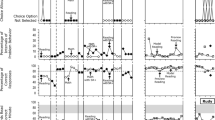Abstract
Research has shown that variability may be an operant dimension of behavior. One method of reinforcing response variability is to use a lag schedule of reinforcement (Page & Neuringer, 1985). Several studies have shown that a Lag 1 schedule is effective in increasing variable responding with human participants (e.g., Esch, Esch, & Love, 2009; Lee, McComas, & Jawor, 2002). In these arrangements, however, the return to baseline responding during reversal phases suggests that the resulting behavior change may not be maintained following intervention. The purpose of the present study was to investigate the effects of a Lag 3 schedule on increasing and maintaining variability of tacts in 2 children diagnosed with developmental disabilities. Results demonstrated increased variability in tacting for both participants and maintenance in variable responding after a 3-week follow-up.
Similar content being viewed by others
References
American Psychiatrie Association. (2000). Diagnostic and statistical manual of mental disorders (Revised 4th ed.). Washington, DC: Author.
DeLeon, I. G., & Iwata, B. A. (1996). Evaluation of a multiple stimulus presentation format for assessing reinforcer preferences. Journal of Applied Behavior Analysis, 29, 519–533.
Esch, J. W., Esch, B. E., & Love, J. R. (2009). Increasing vocal variability in children with autism using a lag schedule of reinforcement. The Analysis of Verbal Behavior, 25, 73–78.
Goetz, E. M., & Baer, D. M. (1973). Social control of form diversity and the emergence of new forms in children’s block-building. Journal of Applied Behavior Analysis, 6(2), 209–217.
Lee, R., McComas, J. J., & Jawor, J. (2002). The effects of differential and lag reinforcement schedules on varied verbal responding by individuals with autism. Journal of Applied Behavior Analysis, 35(4), 391–402.
Machado, A. (1992). Behavioral variability and frequency-dependent selection. Journal of the Experimental Analysis of Behavior, 58(2), 241–263.
Manabe, K., Staddon, J. E. R., & Cleaveland, J. M. (1997). Control of vocal repertoire by reward in budgerigars (Melopsittacus undulatus). Journal of Comparative Psychology, 111, 50–62.
Miller, N., & Neuringer, A. (2000). Reinforcing variability in adolescents with autism. Journal of Applied Behavior Analysis, 33(2), 151–165.
Page, S., & Neuringer, A. (1985). Variability is an operant. Journal of Experimental Psychology: Animal Behavior Processes, 11, 429–452.
Partington, J. W. (2008). The assessment of basic language and learning skills: ABLLS-R Protocol. Pleasant Hill, CA: Behavior Analysts.
Susa, C. L., & Schlinger, H. D. (2012). Using a lag schedule to increase variability of verbal responding in an individual with autism. The Analysis of Verbal Behavior, 28, 125–130.
Author information
Authors and Affiliations
Corresponding author
Additional information
This article is based on a thesis submitted by the first author, under the supervision of the second author, in partial fulfillment of the requirements for the master of arts degree in Applied Behavior Analysis at The Chicago School of Professional Psychology. The authors are grateful to Eric Carlson for his comments and suggestions on an earlier version of the manuscript.
Rights and permissions
About this article
Cite this article
Heldt, J., Schlinger, H.D. Increased Variability in Tacting Under a Lag 3 Schedule of Reinforcement. Analysis Verbal Behav 28, 131–136 (2012). https://doi.org/10.1007/BF03393114
Published:
Issue Date:
DOI: https://doi.org/10.1007/BF03393114




